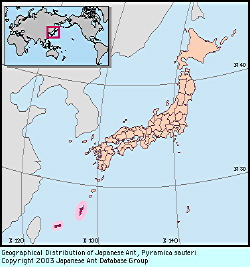
|
species
|
Pyramica sauteri
|
 |
Japanese Name
|
Hime-hirata-uroko-ari
|
Original Reference
|
|
Forel, A. (1912) H. Sauter's Formosa-Ausbeute: Formicidae. Entomologische Mitteilungen 1: 45-81.
|
Synonym
|
|
Pentastruma sauteri Forel, 1912a,
Pyramica sauteri (Forel): Bolton, 1999,
|
Description
|
|
Total length of workers around 2 mm. Body color yellowish brown. Very similar to Pyramica canina but with the following differences: smaller size; shorter mandibles, which have the teeth on their masticatory margins almost even in size; anterior corners of clypeus more rounded and anterior clypeus margin more deeply concave.
|
Remarks
|
|
This species was first described from Pilam, Taiwan. In the original description Forel counted 5 antennal segments are in fact 6, as demonstrated by Brown & Boisvert (1979). The first Japanese record of P. sauteri was from Mt. Yonaha-dake, Okinawa, by Terayama (1985). P. sauteri is also present in the Ishigaki Islands (Ogata, unpublished). A rare species found on the floor of broadleaf forests.
|
|

Distribution
|
|
Nansei Is (Okinawa I., Ishigaki I.); Taiwan.
|
|
References
|
|
- Brown, W. L., Jr. & R. G. Boisvert (1979). The dacetine ant genus Pentastruma (Hymenoptera: Formicidae). . Psyche, 85, 201-207.
- Terayama, M. (1985). New records of ants from the Nansei Islands, Japan. . Ari , (13), 8.
- H. Sauter's Formosa-Ausbeute: Formicidae. Entomologische Mitteilungen 1: 45-81.
- Bolton, B. 1999. Ant genera of the tribe Dacetonini (Hymenoptera: Formicidae). J. Nat. Hist., 33: 1639-1689.
|
Editor
|
|
Original text by Kazuo Ogata and Keiichi Onoyama. English translation by Kazuo Ogata, edited by Robert W. Taylor. Revised by Masashi Yoshimura.
|
|